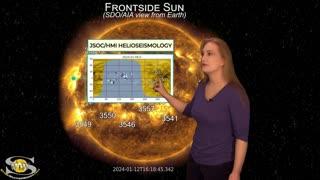A Bright Region Fizzles & A Dark Hole Looms: Solar Storm Forecast 04-05-2018
The Sun has settled down this week after what looked to be a promising beginning. We had high hopes for region 2703 as it rotated into Earth view, but it has since fizzled and we are now once again with a spotless Sun. The bright region that was once 2703 remains visible and it still shows signs of life, but solar flux remains at solar minimum conditions. This is bad news for amateur radio operators and emergency responders, who were hoping for better radio propagation. As for aurora, there is a small chance this week for shows at high latitudes due to a remnant coronal hole sending pockets of fast solar wind, but things will likely remain quiet at mid-latitudes. However, more chances for solar storming come next week, when a large coronal hole gives us a much better chance for aurora. Catch more details on this coronal hole, learn how region 2703 is affecting amateur radio and GPS operations, and see what else the Sun has in store this week!
For daily and often hourly updates (during active times) visit me on Twitter:
https://twitter.com/TamithaSkov
For a more in-depth look at the data and images highlighted in this video see these links below.
Solar Imaging and Analysis:
SDO: http://sdo.gsfc.nasa.gov/data/
Helioviewer: http://www.helioviewer.org/
Flare Analysis: http://www.lmsal.com/solarsoft/latest_events/
Computer Aided CME Tracking CACTUS: http://www.sidc.oma.be/cactus/out/latestCMEs.html
GOES Xray: http://www.swpc.noaa.gov/rt_plots/xray_1m.html
SOHO: http://sohodata.nascom.nasa.gov/
Stereo: http://stereo.gsfc.nasa.gov/
GONG magnetic field synoptic movie: https://gong.nso.edu/data/magmap/standard_movie.html
GONG magnetic field synoptic charts: http://gong.nso.edu/data/magmap/
LMSAL Heliophysics Events HEK http://www.lmsal.com/isolsearch
Solar Wind:
DISCOVR solar wind: http://www.swpc.noaa.gov/products/real-time-solar-wind
ACE Solar Wind: http://www.swpc.noaa.gov/products/ace-real-time-solar-wind
NASA ENLIL SPIRAL: https://iswa.gsfc.nasa.gov/IswaSystemWebApp/iSWACygnetStreamer?timestamp=2038-01-23+00%3A44%3A00&window=-1&cygnetId=261
NOAA ENLIL SPIRAL: http://www.swpc.noaa.gov/products/wsa-enlil-solar-wind-prediction
Magnetosphere, Ionosphere, Atmosphere:
GOES Magnetometer: http://www.swpc.noaa.gov/products/goes-magnetometer
Ionosphere D-Region Absorption (DRAP) model: http://www.swpc.noaa.gov/products/d-region-absorption-predictions-d-rap/
Auroral Oval Ovation Products: http://www.swpc.noaa.gov/products/aurora-30-minute-forecast
Global 3-hr Kp index: http://www.swpc.noaa.gov/products/planetary-k-index
Wing Kp index prediction: http://www.swpc.noaa.gov/products/wing-kp
USGS Ground Magnetometers: http://geomag.usgs.gov/realtime/
USGS Disturbance Storm-Time (Dst): http://geomag.usgs.gov/realtime/dst/
NAIRAS Radiation Storm Model: http://sol.spacenvironment.net/raps_ops/current_files/globeView.html
Multi-Purpose Space Environment Sites:
NOAA/SWPC: http://www.swpc.noaa.gov
SOLARHAM: http://www.solarham.net/index.htm
Spaceweather: http://spaceweather.com
iSWA: http://iswa.gsfc.nasa.gov/iswa/iSWA.html
Definition of Geomagnetic Storm, Radiation Storm, and Radio Blackout Levels:
http://www.swpc.noaa.gov/NOAAscales/
None of this would be possible without the hard work and dedication of those who have provided all of this data for public use.
Images c/o NASA/ESA/CSA (most notably the superb SDO, SOHO, ACE, STEREO, CCMC, JPL & DSN teams, amazing professionals, hobbyists, institutions, organizations, agencies and amateurs such as those at the USAF/HAARP, NICT, NOAA, USGS, Environment Canada, Natural Resources Canada, Intellicast, Catatania, rice.edu, wisc.edu, sonoma.edu ucalgary.ca, rssi.ru, ohio-state.edu, solen.info, and more. Thanks for making Space Weather part of our every day dialogue.
-
 9:13
9:13
Dr. Tamitha Skov
5 months ago $0.07 earnedSide Swiping Solar Storms & East Limb Action | Space Weather Spotlight 13 January 2024
1251 -
 40:37
40:37
Destene and Brandon
1 day agoWe saw our baby for the first time! | Destene and Brandon
633 -
![[LIVE] Something BIG is Happening...](https://hugh.cdn.rumble.cloud/s/s8/1/V/J/j/H/VJjHs.0kob-small-LIVE-Something-BIG-is-Happe.jpg) 1:05:56
1:05:56
Man in America
11 hours ago[LIVE] Something BIG is Happening...
23.8K113 -
 6:47
6:47
Vigilant News Network
19 hours agoSupreme Court Drops Bombshell Ruling | Beyond the Headlines
32.4K52 -
 2:55:23
2:55:23
Fresh and Fit
9 hours agoHeated Debate: Should Women Marry Young?
96.3K134 -
 6:02:27
6:02:27
SNEAKO
11 hours agoSNEAKO X MYSTERY CHRISTIAN GUEST
140K87 -
 13:37
13:37
Plan Bri Uncut
19 hours agoThe Woman Behind The Viral HAWK TUAH Meme Speaks Out For The First Time
74.4K97 -
 5:07:21
5:07:21
Drew Hernandez
11 hours agoMELTDOWN: LEFTISTS PANIC AFTER SCOTUS TRUMP RULING
80.2K51 -
 1:42:30
1:42:30
Fresh and Fit
11 hours agoDonovan Sharpe Returns
76.2K45 -
 1:30:05
1:30:05
Kim Iversen
12 hours agoWeekend at Biden's: Jill and Hunter To Keep Propping Up Old Joe, SCOTUS Rules Govt Can Censor on Social
99.4K150